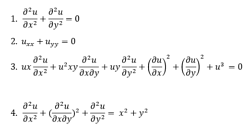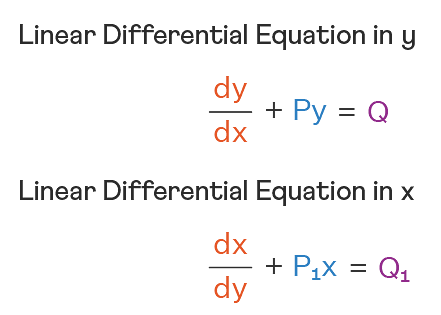Let c, k∈ R. If f(x) = (c + 1)x2 + (1 – c2)x + 2k and f(x + y) = f(x) + f(y) – xy, for all x, y ∈ R, then the value of |2(f(1) + f(2) + f(3) + ......+f (20))| is equal to _____.
Correct Answer: 3395
Solution and Explanation
The correct answer is: 3395
f(x) is polynomial
Put y = 1/x in given functional equation we get
\(f(x+\frac{1}{x})=f(x)+f(\frac{1}{x})-1\)
⇒ 2(c + 1) = 2K – 1 …(1)
and put x = y = 0 we get
\(f(0)=2+f(0)-0⇒f(0)=0⇒k=0\)
∴ k = 0 and 2c = –3 ⇒c = \(–\frac{3}{2}\)
by simplifying we will get
\(=|-\frac{6790}{2}|=3395\)
Top Questions on Relations and functions
If the domain of the function $ f(x) = \log_7(1 - \log_4(x^2 - 9x + 18)) $ is $ (\alpha, \beta) \cup (\gamma, \delta) $, then $ \alpha + \beta + \gamma + \delta $ is equal to
- JEE Main - 2025
- Mathematics
- Relations and functions
- Let $ A = \{0, 1, 2, 3, 4, 5\} $. Let $ R $ be a relation on $ A $ defined by $(x, y) \in R$ if and only if $\max\{x, y\} \in \{3, 4\}$. Then among the statements $ (S_1) : $ The number of elements in $ R $ is 18, and $ (S_2) : $ The relation $ R $ is symmetric but neither reflexive nor transitive Options 1. only $ (S_1) $ is true
2. both are true
3. only $ (S_2) $ is true
4. both are false- JEE Main - 2025
- Mathematics
- Relations and functions
Let $ P_n = \alpha^n + \beta^n $, $ n \in \mathbb{N} $. If $ P_{10} = 123,\ P_9 = 76,\ P_8 = 47 $ and $ P_1 = 1 $, then the quadratic equation having roots $ \alpha $ and $ \frac{1}{\beta} $ is:
- JEE Main - 2025
- Mathematics
- Relations and functions
Let $ A = \{0, 1, 2, 3, 4, 5, 6\} $ and $ R_1 = \{(x, y): \max(x, y) \in \{3, 4 \}$. Consider the two statements:
Statement 1: Total number of elements in $ R_1 $ is 18.
Statement 2: $ R $ is symmetric but not reflexive and transitive.- JEE Main - 2025
- Mathematics
- Relations and functions
Let $ A $ be the set of all functions $ f: \mathbb{Z} \to \mathbb{Z} $ and $ R $ be a relation on $ A $ such that $$ R = \{ (f, g) : f(0) = g(1) \text{ and } f(1) = g(0) \} $$ Then $ R $ is:
- JEE Main - 2025
- Mathematics
- Relations and functions
Questions Asked in JEE Main exam
Let one focus of the hyperbola \( H : \dfrac{x^2}{a^2} - \dfrac{y^2}{b^2} = 1 \) be at \( (\sqrt{10}, 0) \) and the corresponding directrix be \( x = \dfrac{9}{\sqrt{10}} \). If \( e \) and \( l \) respectively are the eccentricity and the length of the latus rectum of \( H \), then \( 9 \left(e^2 + l \right) \) is equal to:
- JEE Main - 2025
- Conic sections
- Let \( \alpha_1 \) and \( \beta_1 \) be the distinct roots of \( 2x^2 + (\cos\theta)x - 1 = 0, \ \theta \in (0, 2\pi) \). If \( m \) and \( M \) are the minimum and the maximum values of \( \alpha_1 + \beta_1 \), then \( 16(M + m) \) equals:
- JEE Main - 2025
- Maxima and Minima
- Let the line \( x + y = 1 \) meet the circle \( x^2 + y^2 = 4 \) at the points A and B. If the line perpendicular to AB and passing through the midpoint of the chord AB intersects the circle at C and D, then the area of the quadrilateral ABCD is equal to:
- JEE Main - 2025
- Coordinate Geometry
- The number of different 5 digit numbers greater than 50000 that can be formed using the digits 0, 1, 2, 3, 4, 5, 6, 7, such that the sum of their first and last digits should not be more than 8, is:
- JEE Main - 2025
- permutations and combinations
- Two identical symmetric double convex lenses of focal length \( f \) are cut into two equal parts \( L_1, L_2 \) by the AB plane and \( L_3, L_4 \) by the XY plane as shown in the figure respectively. The ratio of focal lengths of lenses \( L_1 \) and \( L_3 \) is:

Concepts Used:
Types of Differential Equations
There are various types of Differential Equation, such as:
Ordinary Differential Equations:
Ordinary Differential Equations is an equation that indicates the relation of having one independent variable x, and one dependent variable y, along with some of its other derivatives.
\(F(\frac{dy}{dt},y,t) = 0\)
Partial Differential Equations:
A partial differential equation is a type, in which the equation carries many unknown variables with their partial derivatives.

Linear Differential Equations:
It is the linear polynomial equation in which derivatives of different variables exist. Linear Partial Differential Equation derivatives are partial and function is dependent on the variable.

Homogeneous Differential Equations:
When the degree of f(x,y) and g(x,y) is the same, it is known to be a homogeneous differential equation.
\(\frac{dy}{dx} = \frac{a_1x + b_1y + c_1}{a_2x + b_2y + c_2}\)
Read More: Differential Equations